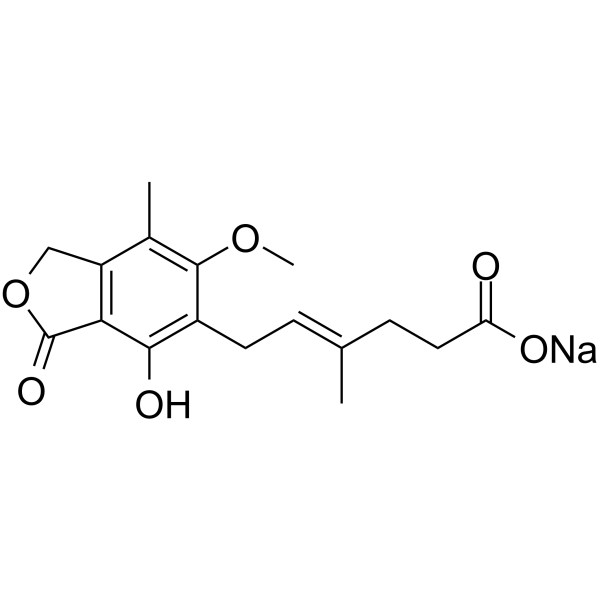MYCOPHENOLATE SODIUM
Modify Date: 2025-08-25 16:39:25

MYCOPHENOLATE SODIUM structure
|
Common Name | MYCOPHENOLATE SODIUM | ||
|---|---|---|---|---|
| CAS Number | 37415-62-6 | Molecular Weight | 343.32700 | |
| Density | 1.29 g/cm3 | Boiling Point | 611.6ºC at 760 mmHg | |
| Molecular Formula | C17H20NaO6+ | Melting Point | N/A | |
| MSDS | N/A | Flash Point | 225.8ºC | |
Use of MYCOPHENOLATE SODIUMMycophenolic acid sodium is a potent uncompetitive inosine monophosphate dehydrogenase (IMPDH) inhibitor with an EC50 of 0.24 µM. Mycophenolic acid sodium demonstrates antiviral effects against a wide range of RNA viruses including influenza. Mycophenolic acid sodium is an immunosuppressive agent. Antiangiogenic and antitumor effects[1][2]. |
| Name | mycophenolate sodium |
|---|---|
| Synonym | More Synonyms |
| Description | Mycophenolic acid sodium is a potent uncompetitive inosine monophosphate dehydrogenase (IMPDH) inhibitor with an EC50 of 0.24 µM. Mycophenolic acid sodium demonstrates antiviral effects against a wide range of RNA viruses including influenza. Mycophenolic acid sodium is an immunosuppressive agent. Antiangiogenic and antitumor effects[1][2]. |
|---|---|
| Related Catalog | |
| In Vitro | Mycophenolic acid sodium demonstrates antiviral effects against a wide range of RNA viruses including influenza, dengue virus, Zika virus, rotavirus, CCHFV, and hantavirus[1]. IMPDH is the rate-limiting enzyme in the de novo synthesis of guanosine nucleotides[2]. Mycophenolic acid (0.01-1 μM; 72 hours) sodium exhibits preferential antiproliferative activity against the endothelial cells and fibroblasts. Endothelial cells are most sensitive cells to Mycophenolic acid treatment with an IC50 <500 nM for antimitotic effects[2]. Fibroblasts are also prone to Mycophenolic acid-induced cell cycle inhibition but exhibit a higher IC50 (<1 μM) compared with endothelial cells. The two human tumor cell lines A549 non-small cell lung cancer cells and PC3 prostate cancer cells show intermediate sensitivity with an IC50 >1 μM. U87 glioblastoma cells are resistant against Mycophenolic acid sodium treatment up to 1 μM[2]. Mycophenolic acid (0.05-2 μM; 18 hours) sodium exhibits a dose-dependent down-regulation of HDAC2 and MYC, whereas up-regulates NDRG1[2]. Cell Proliferation Assay[2] Cell Line: Primary isolated human dermal microvascular endothelial cells (HDMVEC) , fibroblasts, U87 glioblastoma cells, PC3 prostate cancer cells, A549 non-small cell lung cancer cells. Concentration: 0.01, 0.1, 1 μM Incubation Time: 72 hours Result: Exhibited preferential antiproliferative activity against HDMVEC and fibroblasts. Whereas U87 glioblastoma cells were resistant to treatment, A549 non-small cell lung cancer and PC3 prostate cancer cells showed intermediate sensitivity. Western Blot Analysis[2] Cell Line: HDMVEC Concentration: 0, 0.05, 0.1, 0.5, 1, and 2 μM Incubation Time: 18 hours Result: Showed a dose-dependent regulation of HDAC2, MYC, and NDRG1. |
| In Vivo | Mycophenolic acid (120 mg/kg; oral gavage; b.i.d.) sodium exerts its antitumor effects via modulation of the tumor microenvironment, U87 tumor growth is markedly inhibited in vivo in BALB/c nude mice[2]. Animal Model: Athymic 8-week-old, 20 g BALB/c nu/nu mice bearing Mycophenolic acid-resistant human U87 tumor model[2] Dosage: 120 mg/kg MMF (the morpholinoethyl ester prodrug of Mycophenolic acid) Administration: Oral gavage; b.i.d. Result: MMF (the morpholinoethyl ester prodrug of Mycophenolic acid) significantly inhibited tumor growth (∼70% after day 14 after tumor implantation) in MMF-treated versus control mice. Microvessel density (CD31 staining) and pericyte coverage determined by α-smooth muscle actin staining were markedly reduced in MMF-treated versus control tumors (44% and 78%, respectively). |
| References |
| Density | 1.29 g/cm3 |
|---|---|
| Boiling Point | 611.6ºC at 760 mmHg |
| Molecular Formula | C17H20NaO6+ |
| Molecular Weight | 343.32700 |
| Flash Point | 225.8ºC |
| Exact Mass | 343.11600 |
| PSA | 93.06000 |
| LogP | 2.73320 |
| InChIKey | DOZYTHNHLLSNIK-JOKMOOFLSA-M |
| SMILES | COc1c(C)c2c(c(O)c1CC=C(C)CCC(=O)[O-])C(=O)OC2.[Na+] |
CHEMICAL IDENTIFICATION
HEALTH HAZARD DATAACUTE TOXICITY DATA
MUTATION DATA
|
| RIDADR | UN 2811 6.1 / PGIII |
|---|
| mycophenolicmonosodiumsalt |
| MYCOPHENOLATE SODIUM |
| Mycophenolic acid monosodium salt |
| sodiummycophenolate |
| mycophenolicacidmonosodiumsalt |